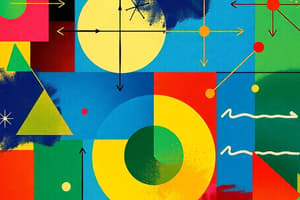Podcast
Questions and Answers
Which branch of mathematics primarily deals with the relationships between angles and sides of triangles?
Which branch of mathematics primarily deals with the relationships between angles and sides of triangles?
- Algebra
- Trigonometry (correct)
- Geometry
- Calculus
The concept of sets in mathematics involves collections of well-defined objects.
The concept of sets in mathematics involves collections of well-defined objects.
True (A)
What are the two main types of calculus?
What are the two main types of calculus?
Differential calculus and integral calculus
The branch of mathematics called ______ explores shapes, sizes, and properties of space.
The branch of mathematics called ______ explores shapes, sizes, and properties of space.
Match the following mathematical concepts with their corresponding descriptions:
Match the following mathematical concepts with their corresponding descriptions:
Which of the following is NOT a core concept or principle in mathematics?
Which of the following is NOT a core concept or principle in mathematics?
Complex numbers are a subset of real numbers.
Complex numbers are a subset of real numbers.
What is the primary application of mathematics in computer science?
What is the primary application of mathematics in computer science?
Which of the following is NOT a key step in solving a mathematical problem?
Which of the following is NOT a key step in solving a mathematical problem?
Mathematical notation is essential for clarity in presenting and interpreting mathematical expressions.
Mathematical notation is essential for clarity in presenting and interpreting mathematical expressions.
What are two examples of software used for mathematical calculations and simulations?
What are two examples of software used for mathematical calculations and simulations?
________ is crucial for understanding the requirements of a mathematical problem.
________ is crucial for understanding the requirements of a mathematical problem.
Match each mathematical tool with its primary purpose.
Match each mathematical tool with its primary purpose.
Flashcards
Mathematics
Mathematics
A fundamental science focused on abstract concepts like quantity and change.
Algebra
Algebra
A branch of mathematics that manipulates symbols and equations.
Geometry
Geometry
The study of shapes, sizes, and properties of space.
Calculus
Calculus
Signup and view all the flashcards
Functions
Functions
Signup and view all the flashcards
Logic
Logic
Signup and view all the flashcards
Real Numbers
Real Numbers
Signup and view all the flashcards
Number Theory
Number Theory
Signup and view all the flashcards
Problem Solving Steps
Problem Solving Steps
Signup and view all the flashcards
Mathematical Notation
Mathematical Notation
Signup and view all the flashcards
Mathematical Tools
Mathematical Tools
Signup and view all the flashcards
IMPORTANCE of Mathematics
IMPORTANCE of Mathematics
Signup and view all the flashcards
Identifying Key Information
Identifying Key Information
Signup and view all the flashcards
Study Notes
Introduction to Mathematics
- Mathematics is a fundamental science concerned with abstract concepts like quantity, structure, space, and change.
- It uses symbolic language to represent and manipulate these concepts, enabling the formulation and solution of problems.
- Key branches include algebra, geometry, calculus, and analysis.
Branches of Mathematics
- Arithmetic: Deals with basic operations on numbers (addition, subtraction, multiplication, division).
- Algebra: Focuses on manipulating symbols and equations to solve problems. Includes topics like linear equations, quadratic equations, and polynomial equations.
- Geometry: Explores shapes, sizes, and properties of space. Includes plane geometry (2D) and solid geometry (3D).
- Trigonometry: Studies relationships between angles and sides of triangles, crucial in applications such as surveying and navigation.
- Calculus: Deals with continuous change. Includes differential calculus (rates of change) and integral calculus (accumulation of quantities).
- Analysis: A broad field encompassing topics like limits, continuity, differentiation, integration, and infinite series. Provides rigorous tools for studying functions and their properties.
- Number Theory: Studies the properties of numbers, including prime numbers, divisibility, and modular arithmetic.
Core Concepts and Principles
- Sets: A collection of well-defined objects. Operations on sets (union, intersection, complement).
- Functions: A relationship between two sets, where each element in the first set is associated with exactly one element in the second set.
- Logic: Deals with the principles of reasoning and valid arguments. Uses concepts like propositions, connectives, and quantifiers.
- Proofs: Establishing the truth of a mathematical statement using logical deduction. Different types of proofs exist, such as direct proof, proof by contradiction.
- Real Numbers: Include rational and irrational numbers, with properties like ordering and field axioms.
- Complex Numbers: Numbers in the form a + bi, where a and b are real numbers and i is the imaginary unit. Includes extensions of operations on real numbers.
Applications of Mathematics
- Science and Engineering: Essential for modeling physical phenomena, solving engineering problems, and developing new technologies.
- Computer Science: Fundamental in algorithms, data structures, cryptography, and computer graphics.
- Finance: Used in risk assessment, portfolio management, and economic modeling.
- Statistics: Employs mathematical tools to analyze data, draw inferences, and make predictions.
- Social Sciences: Mathematical models can be applied to various areas, like population dynamics, econometrics, and sociology.
Problem Solving Strategies in Mathematics
- Identifying Key Information: Crucial to understand the problem's requirements.
- Developing a Plan: Outline the steps needed to solve the problem (e.g., using formulas, drawing diagrams).
- Executing the Plan: Carry out the steps accurately.
- Evaluating the Solution: Checking the validity of the answer and if it agrees with the context of the problem.
Mathematical Notation
- Symbols: Different symbols represent different mathematical concepts, used to simplify expressions and present ideas.
- Formatting: Equations, variables, and expressions are formatted to maintain clarity, emphasizing different components. Understanding formatting ensures correct interpretation.
Mathematical Tools and Resources
- Calculators: Useful for numerical computations and verifying results.
- Software: Specific software like MATLAB and Mathematica support symbolic computation, simulations.
- Textbooks and Online Resources: Provide comprehensive information and examples for learning.
- Study Groups and Tutors: Effective for discussions, feedback, and addressing knowledge gaps.
Importance of Mathematics
- Critical Thinking Skills: Enhances logical reasoning and problem-solving abilities.
- Foundation for Other Subjects: Mathematics serves as a core foundation for many disciplines, from science and engineering to economics and finance.
- Abstraction and Pattern Recognition: Develops the ability to recognize patterns and draw logical conclusions from abstract concepts.
Studying That Suits You
Use AI to generate personalized quizzes and flashcards to suit your learning preferences.




